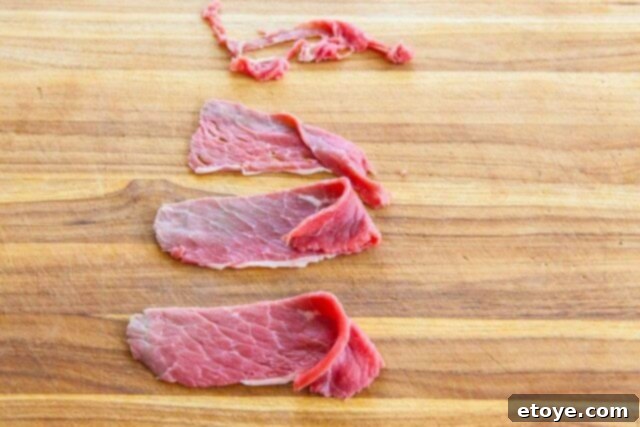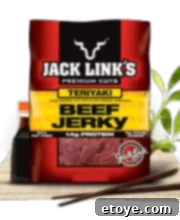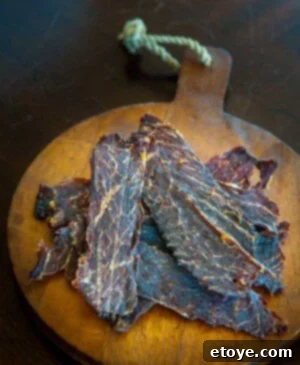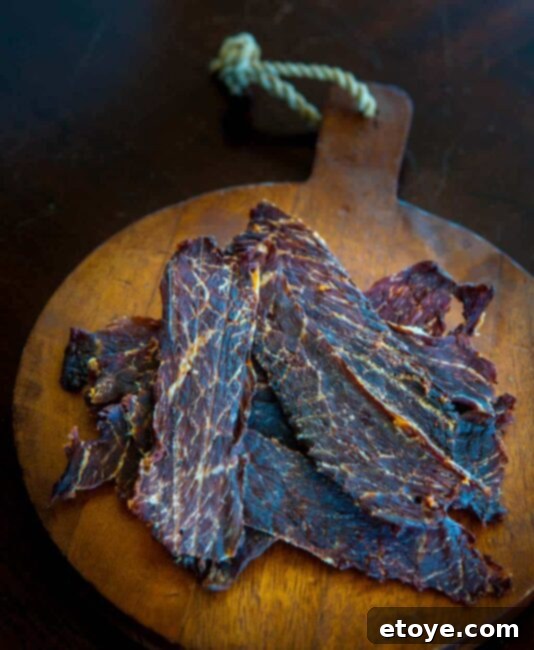Homemade Korean Beef Jerky: Your Guide to a Flavorful, Healthy Snack
Craving a delicious, protein-packed snack that’s both savory and sweet? Look no further than homemade Korean beef jerky! This guide will walk you through creating a truly unforgettable jerky experience, infused with the vibrant flavors of traditional Korean BBQ marinade. Forget store-bought versions filled with artificial ingredients; preparing your own jerky allows for complete control over quality, ingredients, and flavor, resulting in a healthy, wholesome treat you’ll be proud to share.
Our recipe combines thinly sliced, lean beef (we highly recommend London Broil for its optimal texture and leanness) with a rich, aromatic Korean BBQ-inspired marinade. The result is a tender, chewy jerky that perfectly balances umami, a hint of sweetness, and a delightful garlicky kick. Get ready to elevate your snack game and enjoy the satisfaction of crafting your own gourmet beef jerky right at home.

Essential Tips for Crafting Perfect Korean Style Beef Jerky
Achieving outstanding homemade beef jerky requires attention to detail. These expert tips will ensure your Korean jerky turns out consistently delicious, batch after batch.
The Power of Precision Slicing: Why a Meat Slicer is Your Best Friend
For truly professional-grade beef jerky, a meat slicer is an invaluable tool. While a sharp knife can get the job done, an electric meat slicer offers unparalleled precision, creating uniform, thin slices that are crucial for even drying. Investing in an inexpensive meat slicer, often available for under $100 on platforms like Amazon, will dramatically improve your jerky-making process. Uneven slices can lead to some pieces being over-dried and brittle, while others remain too moist, creating inconsistencies in texture and shelf life across your batch. With a slicer, every piece finishes drying at the same time, guaranteeing perfect chewiness and flavor in every bite.
When operating an electric slicer, always exercise caution. Although modern slicers come equipped with safety features, remember you are working with a rotating blade. Always keep your fingers clear, use the food pusher, and follow the manufacturer’s safety guidelines diligently.

Elevate Your Marinade: Garlic Powder vs. Fresh Garlic
While traditional Korean BBQ marinades often feature fresh minced garlic, for jerky, we highly recommend using garlic powder. Here’s why: Garlic powder provides a more concentrated, consistent garlic flavor that permeates the thin beef slices effectively. Fresh garlic, on the other hand, can sometimes burn during the dehydration process, leading to a bitter taste or visible charred bits on your jerky. The fine texture of garlic powder also ensures a smoother marinade that adheres better to the meat without clumping. Similarly, onion powder can be used in place of grated fresh onion for the same reasons, offering a potent flavor without the added moisture or potential for burning.
Optional Flavor Boost: Roasted Sesame Seeds
To add an extra layer of nutty aroma and visual appeal, consider incorporating roasted sesame seeds into your marinade. They impart a subtle yet distinct toasted flavor that complements the Korean BBQ profile beautifully. You can sprinkle them directly into the marinade or, for best results, lightly toast them in a dry pan until fragrant before adding to enhance their flavor even further.


Choosing the Perfect Beef for Korean Beef Jerky
The foundation of exceptional beef jerky starts with selecting the right cut of meat. After extensive testing, we’ve consistently found London Broil to be the top choice for its ideal characteristics for jerky making. Understanding what London Broil truly means can help you make an informed decision at the butcher shop.
Understanding London Broil: More Than Just a Cut
It’s important to note that “London Broil” is actually a culinary term describing a cooking method, not a specific butcher’s cut. However, in many American supermarkets, you’ll find cuts of beef labeled “London Broil” that are typically thick, lean, and flat. These are most commonly Top Round Steak, specifically cut to an even thickness. Occasionally, Flank Steak might also be labeled as London Broil. While Flank Steak can be used, we generally prefer Top Round for jerky as Flank Steak is often too thin and can result in jerky that’s overly narrow or less satisfyingly chewy.
The London Broil (or Top Round Steak) we recommend is typically about 1.75 inches thick. This thickness allows for beautiful, consistent slices of jerky that are substantial enough to provide a satisfying chew without being overly tough. When inspecting your meat, prioritize an even thickness throughout the cut and, most importantly, look for very little visible fat. Dehydrated fat can develop an unpleasant, rancid flavor and a waxy texture, significantly detracting from the overall jerky experience. A lean cut ensures your jerky is flavorful, tender, and has a longer shelf life.
When preparing your meat, if you opt for Flank Steak, remember to slice *across* the grain. This is crucial for breaking down the tough muscle fibers, ensuring a tender and palatable jerky. For Top Round, slicing against the grain is also recommended for optimal tenderness. The photo on the left illustrates a prime example of a lean, evenly thick Top Round Steak, perfect for making those half-inch-wide strips of delicious Korean beef jerky. Photo source
Determining the Ideal Thickness for Your Korean Beef Jerky
The thickness of your beef jerky slices is a matter of personal preference, significantly impacting both the final taste and texture. While some prefer a hearty, thick piece of jerky that truly exercises the jaw, we find that thinner slices often yield a superior experience in several aspects.
Thinner jerky typically wins in terms of taste concentration, as the marinade penetrates more deeply and quickly. The texture is often more tender and less prone to becoming overly tough. Furthermore, thinner slices are easier and quicker to enjoy, and they require less marinating and dehydrating time. For those seeking a more traditional, easy-to-chew jerky, a thinner slice is generally preferred.
Using a meat slicer allows you to precisely control the thickness. Most slicers come with a numbered dial, offering a range of settings. For instance, on a dial from 0 to 10, a setting of 0.5 would produce paper-thin slices, which might be too delicate for jerky. A setting of 1.5 would result in thicker, more substantial pieces. Through experimentation, we’ve found that a setting of 1.25 strikes an excellent balance, creating slices that are thin enough for rapid flavor absorption and efficient drying, yet robust enough to provide a satisfying chew. We encourage you to test different thicknesses with your slicer to discover your own perfect jerky texture.

Crafting a Delicious Marinade for Your Beef Jerky
The marinade is where the magic happens, infusing your beef with the irresistible savory-sweet notes characteristic of Korean cuisine. Our marinade is a harmonious blend of low-sodium soy sauce, rich brown sugar, aromatic garlic powder, pungent onion powder, and nutty Asian sesame oil. Each ingredient plays a vital role:
- **Low Sodium Soy Sauce:** Provides a deep umami base and essential saltiness without overpowering the other flavors. Using low-sodium allows for better control over the final salt content.
- **Brown Sugar:** Adds a delicate sweetness that balances the savory elements and contributes to a beautiful caramelized finish during dehydration.
- **Garlic and Onion Powder:** These concentrated aromatics deliver a robust flavor profile that is foundational to Korean BBQ, ensuring maximum flavor penetration into the thin beef slices.
- **Asian Sesame Oil:** Imparts a distinctive nutty aroma and a touch of richness, rounding out the complex flavors of the marinade.
The Marinade Process: Maximizing Flavor Absorption
After you’ve meticulously sliced your beef to your desired thickness, it’s time to prepare the marinade. Combine all the marinade ingredients in a large, resealable freezer bag. Add your thinly sliced meat to the bag, seal it, and gently massage and shake the bag to ensure every piece of beef is thoroughly coated. This hands-on approach guarantees uniform flavor distribution.
Here’s a pro tip for optimal marination: Once the meat is coated, unseal a tiny opening in the bag and squeeze out as much air as possible before quickly resealing it. This technique creates a vacuum-like effect, drawing the marinade closer to the meat and preventing it from settling at the bottom of the bag. This ensures the marinade is working its magic on every surface of the beef.
Given the thinness of the meat slices, a short marinating time is usually sufficient. We find that just 30 minutes yields a perfectly seasoned jerky – enough flavor without becoming overly salty. We prefer a lightly seasoned jerky that doesn’t leave you parched! However, if you opt for thicker slices, you can extend the marinating time to an hour or even overnight in the refrigerator for a more intense flavor. Always refrigerate if marinating for longer than 30 minutes to ensure food safety.
Making Korean Beef Jerky in a Dehydrator
A food dehydrator is the cornerstone of successful homemade jerky, providing a consistent, low-heat environment that slowly removes moisture from the meat, resulting in that perfectly chewy texture. We’ve had great success with the Nesco SnackMaster Pro Dehydrator, which offers reliable performance and is quite affordable. While some advanced dehydrators include built-in timers, a simple external timer or even your phone’s timer can easily suffice.
Loading and Drying Your Beef Jerky
Once your beef is marinated and ready, arrange the slices on the dehydrator racks in a single layer. It’s crucial to spread them out, ensuring no pieces are overlapping or curled. This allows for optimal airflow and even drying, preventing any spots from remaining damp. Follow your dehydrator manufacturer’s instructions for temperature and estimated drying times, as these can vary between models. Generally, beef jerky is dehydrated at temperatures between 145-160°F (63-71°C) until it is firm, dry, and chewy, but still pliable without breaking.
Cleaning Your Dehydrator Racks
Cleaning dehydrator racks after making jerky can be a bit challenging due to stubborn dried bits of marinade and meat. Here’s a helpful tip: Instead of attempting to scrub them by hand, simply place the racks in your dishwasher. The hot water and powerful jets will effectively soften and remove most of the dried residue, making cleanup a breeze. If you don’t have a dishwasher, a good soak in hot, soapy water before scrubbing can also work wonders.
Environmental Considerations
Dehydrators emit warm air, which can slightly increase the temperature in your home, especially during hot summer months. To avoid heating up your living space, consider placing your dehydrator on a covered patio or in a well-ventilated garage while it’s running. This allows the warm air to dissipate outdoors without affecting your indoor comfort.

Homemade Jerky vs. Store-Bought: A Clear Winner
When it comes to beef jerky, the difference between homemade and store-bought is night and day. Making your own jerky offers significant advantages in terms of health, taste, and cost.
Store-Bought Beef Jerky: “Jack Link’s Teriyaki Flavored” Example

Consider a typical commercial product like “Jack Link’s Teriyaki Flavored” beef jerky. The ingredient list often includes:
- Beef, water, sugar, dried soy sauce (soybeans, salt, wheat), maltodextrin, fructose, monosodium glutamate (MSG), flavorings, hydrolyzed corn protein, sodium erythorbate, paprika extract, sodium nitrate.
While convenient, these products often raise concerns:
- The exact type and quality of beef are often unspecified.
- They frequently contain MSG, a flavor enhancer, and a host of other chemicals and additives that can be difficult to pronounce and understand.
- A small 3.5-ounce bag can cost around $5.99, making it a relatively expensive snack per ounce.
Homemade Beef Jerky: Quality, Control, and Savings

In contrast, homemade Korean beef jerky offers transparency and superior quality:
- **Ingredients:** Top Round steak (or London Broil), Soy sauce (soybeans, salt, wheat), sesame oil, garlic powder, onion powder, brown sugar. You know exactly what goes into your food.
- **Dietary Alternatives:** For those with dietary restrictions, soy sauce can easily be substituted with Coconut Aminos, providing a delicious wheat and soy-free alternative without compromising flavor.
- **Beef Quality:** You have the freedom to choose high-quality cuts, including organic or free-range beef, aligning with your personal health and ethical preferences.
- **Cost-Effective:** Typically, beef for jerky can be purchased for about $5.29 per pound (especially when on sale). One pound of raw meat yields approximately 6-8 ounces of dehydrated jerky, making it significantly more economical than store-bought options.
Homemade jerky allows you to enjoy a delicious, wholesome snack free from questionable additives, tailored to your taste, and at a fraction of the cost.
Top Tips for Your Korean Beef Jerky Journey
- **Choose London Broil:** This cut remains our top recommendation for its lean profile and ideal thickness, making it perfect for tender, flavorful jerky.
- **Invest in a Deli Slicer:** A meat slicer is not just for jerky; it’s a versatile kitchen tool that ensures uniform slices for deli meats, cheeses, and more. Consider an affordable, home-market-designed unit like the Kalorik Meat and Deli Slicer, which is typically under $100 and compact for easy storage.
- **Master the Air-Squeeze Marinade Technique:** When marinating in a plastic bag, unseal a small section, press out as much air as possible, then quickly reseal. This creates better contact between the meat and marinade, enhancing flavor absorption.
- **Don’t Rush the Marinade:** Allow the beef to marinate for at least 30 minutes for thin slices. For thicker cuts or a more intense flavor, extend the marinating time up to overnight in the refrigerator.
- **Clean Racks Easily:** Toss your dehydrator racks into the dishwasher for effortless cleanup.
- **Consider Drying Outdoors:** Place your dehydrator on a patio during warmer months to avoid heating your home.

Explore More Delicious Recipes
- Steak Recipe: Turning Cheap “Choice” Steak into Gucci “Prime” Steak
- Flank Steak with Bloody Mary Tomato Salad Recipe
- 1-Step, Fail Proof Prime Rib Roast Recipe on the Rotisserie
- Korean Kalbi Baby Back Ribs

Korean Beef Jerky
Jaden Hair
Pin Recipe
Ingredients
- 3 tablespoons low sodium soy sauce
- 3 tablespoons brown sugar
- 1 teaspoon onion powder
- 1 teaspoon garlic powder
- 1 teaspoon Asian sesame oil
- 2 pounds London broil very thinly sliced
Instructions
- In a resealable freezer bag, combine all ingredients except for the meat.
- Add the sliced meat, seal bag and massage gently to incorporate the marinade throughout the meat. Unseal just a small section, push as much air out of the bag as possible, and reseal. Let marinate for 30 minutes (on counter-top at room temperature is fine) or refrigerate up to overnight.
- Lay out the meat in a single layer (as neat as possible) on the dehydrator racks. Set dehydrator according to manufacturer’s instructions.
Notes
A deli slicer is a great implement for beff jerky but also versatile tool in your kitchen. Recently received a Kalorik Meat and Deli Slicer for review that’s designed specifically for the home market. The unit is affordable at less than $100, and small enough to tuck away in the pantry.
When marinading the beef in a plastic bag, unseal just a small section, push as much air out of the bag as possible, and reseal.
Let the beef marinade for at least 30 mins.
